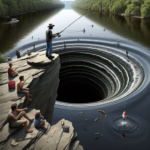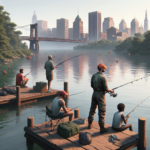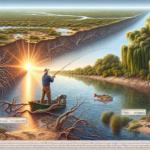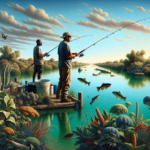Fishing in the Susquehanna River: New York, Pennsylvania, and Maryland

Introduction
Did you know that the Susquehanna River, stretching over 444 miles, is one of the longest rivers on the East Coast of the United States? This majestic river flows through New York, Pennsylvania, and Maryland, offering a diverse and rich fishing experience for anglers of all skill levels. In this article, we will explore the best fishing techniques, species information, top fishing spots, and much more to help you make the most of your fishing adventures on the Susquehanna River.
Whether you’re a seasoned angler looking to master new techniques or a beginner eager to find the best fishing spots, this comprehensive guide will provide you with all the information you need. From understanding the historical and cultural significance of the river to learning about the best times to fish and the essential gear required, we’ve got you covered.
Fishing in the Susquehanna River matters because it offers a unique opportunity to connect with nature, enjoy recreational activities, and contribute to local conservation efforts. Let’s dive in and explore everything you need to know about fishing in this iconic river.
Background/Context
Historical or Cultural Significance
The Susquehanna River has played a crucial role in the history and culture of the regions it flows through. Native American tribes, such as the Susquehannock, relied on the river for sustenance and transportation. European settlers later used the river for trade and commerce. Today, the river remains a vital natural resource, supporting local economies and providing recreational opportunities for residents and visitors alike.
Geographical Overview
The Susquehanna River originates in Otsego Lake in New York and flows southward through Pennsylvania before emptying into the Chesapeake Bay in Maryland. The river’s diverse ecosystem includes various habitats such as freshwater marshes, forests, and rocky outcrops. The climate along the river varies, with cold winters and warm summers, influencing the behavior and availability of fish species throughout the year.
Key Points/Details
Fishing Techniques
Technique Overview
Several fishing techniques are effective on the Susquehanna River, including fly fishing, spin fishing, and baitcasting. Each technique has its own set of advantages and is suited to different species and conditions.
When and Where to Use
Fly fishing is particularly effective in the upper reaches of the river, where trout are abundant. Spin fishing and baitcasting are popular in the middle and lower sections, where bass, catfish, and walleye are commonly found. The best times to use these techniques vary by season, with spring and fall being prime times for most species.
Recommended Gear
- Fly Fishing: 5-7 weight rods, floating lines, and a variety of dry flies, nymphs, and streamers.
- Spin Fishing: Medium to medium-heavy rods, spinning reels, and a selection of soft plastics, crankbaits, and spinnerbaits.
- Baitcasting: Medium-heavy to heavy rods, baitcasting reels, and lures such as jigs, swimbaits, and topwater plugs.
Species Information
Species Overview
The Susquehanna River is home to a wide variety of fish species, including smallmouth bass, largemouth bass, walleye, catfish, and trout. Each species has its own unique habits and preferred habitats.
Best Practices
To successfully catch smallmouth bass, focus on rocky areas and use lures that mimic crayfish or baitfish. For catfish, target deep holes and use cut bait or stink bait. Trout fishing is best in the upper reaches of the river, using flies or small spinners.
Location Information
Top Fishing Spots
- New York: Otsego Lake, Cooperstown area.
- Pennsylvania: Harrisburg area, Sunbury, and the West Branch Susquehanna River.
- Maryland: Conowingo Dam, Susquehanna State Park.
Regulations and Licenses
Fishing regulations and license requirements vary by state. Anglers should check with the New York Department of Environmental Conservation, Pennsylvania Fish and Boat Commission, and Maryland Department of Natural Resources for the latest information on licenses, catch limits, and seasonal restrictions.
Seasonal Considerations
Seasonal Variations
Fishing conditions on the Susquehanna River change throughout the year. Spring and fall are generally the best times for fishing, with cooler water temperatures and active fish. Summer can be productive, but anglers may need to fish early in the morning or late in the evening to avoid the heat. Winter fishing is possible but requires specialized gear and techniques.
Best Times to Fish
The optimal times to fish on the Susquehanna River are early morning and late evening during the warmer months. In the spring and fall, fishing can be productive throughout the day. Pay attention to water levels and weather conditions, as these can significantly impact fish behavior.
Events and Tournaments
Event Overview
The Susquehanna River hosts several fishing events and tournaments throughout the year. Notable events include the Susquehanna River Bassmasters Tournament and the Catfish Challenge. These events attract anglers from all over the region and offer opportunities to compete for prizes and recognition.
Preparation Tips
To prepare for a fishing tournament, ensure your gear is in top condition, practice your techniques, and familiarize yourself with the tournament rules and regulations. Pre-fishing the tournament waters can also give you an advantage by helping you identify productive spots.
Tips and Best Practices
General Tips
- Always check local fishing reports for the latest information on fish activity and water conditions.
- Use a fish finder to locate schools of fish and underwater structures.
- Practice catch and release to help maintain healthy fish populations.
Avoid Common Mistakes
- Not checking local regulations: Always ensure you are aware of the latest fishing regulations and license requirements.
- Using the wrong gear: Match your gear to the species you are targeting and the conditions you are fishing in.
- Ignoring weather conditions: Pay attention to weather forecasts and adjust your plans accordingly.
Advanced Techniques
- Mastering the art of fly fishing: Practice casting techniques and learn to read the water to identify where fish are likely to be.
- Using electronics: Invest in a quality fish finder and learn how to interpret the data to locate fish more effectively.
- Refining your bait presentation: Experiment with different lures and bait presentations to find what works best for the conditions.
Gear and Equipment Recommendations
Essential Gear
- Rods and reels suited to your chosen fishing technique.
- A variety of lures and baits tailored to the species you are targeting.
- Fishing line appropriate for the conditions and species.
- Fishing license and any required permits.
Optional Gear/Upgrades
- Fish finder or depth sounder.
- Waders for fly fishing in shallow areas.
- Portable GPS for navigating the river.
Where to Buy or Rent
Local tackle shops in New York, Pennsylvania, and Maryland offer a wide range of fishing gear and equipment. Online retailers such as Bass Pro Shops, Cabela’s, and Amazon also provide extensive selections. Some local shops may offer rental options for gear such as boats and waders.
Safety and Conservation
Safety Tips
- Always wear a life jacket when fishing from a boat or wading in deep water.
- Be aware of weather conditions and avoid fishing during storms or high winds.
- Carry a first aid kit and know basic first aid procedures.
Conservation Practices
- Practice catch and release to help maintain healthy fish populations.
- Respect local wildlife and avoid disturbing nesting areas or habitats.
- Follow all fishing regulations and report any violations to local authorities.
Planning Your Trip
Accommodations
There are numerous accommodations available near the Susquehanna River, ranging from campgrounds and RV parks to hotels and bed-and-breakfasts. Popular options include the Susquehanna State Park Campground in Maryland, the Harrisburg East Campground in Pennsylvania, and various hotels in Cooperstown, New York.
Travel Tips
When planning your trip, consider the best routes to your chosen fishing spots. Major highways such as I-81 and I-83 provide easy access to many areas along the river. Ensure your vehicle is equipped for transporting fishing gear, and consider renting a boat if you plan to fish from the water.
Additional Activities
In addition to fishing, the Susquehanna River region offers a variety of recreational activities. Hiking, kayaking, and birdwatching are popular options. Historical sites such as the National Baseball Hall of Fame in Cooperstown and the Gettysburg National Military Park in Pennsylvania provide opportunities for cultural exploration.
Frequently Asked Questions (FAQs)
What is the best time of year to fish the Susquehanna River?
The best times to fish are typically in the spring and fall when water temperatures are cooler, and fish are more active. Early morning and late evening are also productive times during the warmer months.
Do I need a fishing license to fish the Susquehanna River?
Yes, a fishing license is required in all three states (New York, Pennsylvania, and Maryland). Be sure to check the specific regulations and obtain the appropriate license for the state you plan to fish in.
What species of fish can I catch in the Susquehanna River?
The river is home to a variety of species, including smallmouth bass, largemouth bass, walleye, catfish, and trout. Each species has its own preferred habitats and seasonal behaviors.
Are there any fishing tournaments on the Susquehanna River?
Yes, several fishing tournaments are held on the Susquehanna River throughout the year, including the Susquehanna River Bassmasters Tournament and the Catfish Challenge. These events offer opportunities for anglers to compete and win prizes.
Conclusion
Fishing in the Susquehanna River offers a unique and rewarding experience for anglers of all skill levels. From mastering various fishing techniques to targeting diverse fish species and exploring top fishing spots, this guide provides all the information you need to make the most of your fishing adventures. Remember to follow local regulations, practice conservation, and prioritize safety to ensure a successful and enjoyable trip. So grab your gear, head to the Susquehanna River, and start creating unforgettable fishing memories today!




